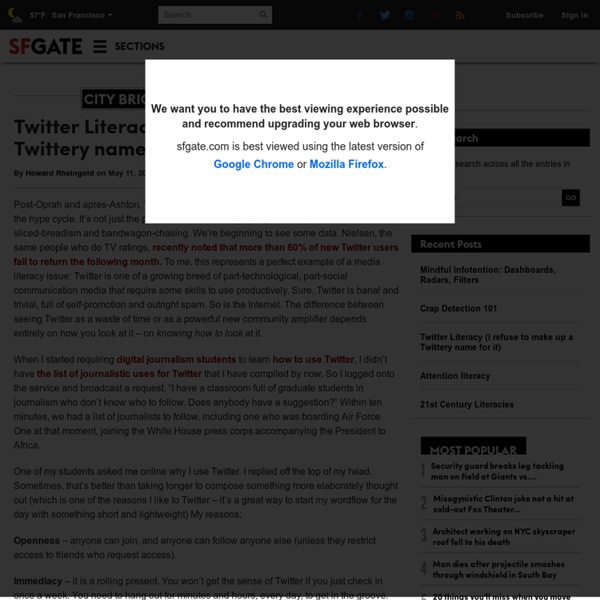Twitter Hacking Victims Find Stolen Accounts Sold On Black Market
Eric Weaver tried logging in to his Twitter account this summer, but he was locked out. A hacker had broken into his account and changed the password. But it didn't end there. With a little digging, Weaver found that his Twitter handle -- @weave -- was being sold in an online forum at HackForums.net. With more digging, he also found that software was being sold online to automate the process of quickly hacking dozens of Twitter accounts. "I was surprised this was all happening so openly," said Weaver, an advertising executive in Seattle.
U
Rheingold U. is a totally online learning community, offering courses that usually run for five weeks, with five live sessions and ongoing asynchronous discussions through forums, blogs, wikis, mindmaps, and social bookmarks. In my thirty years of experience online and my eight years teaching students face to face and online at University of California, Berkeley and Stanford University, I've learned that magic can happen when a skilled facilitator works collaboratively with a group of motivated students. Live sessions include streaming audio and video from me and from students, shared text chat and whiteboard, and my ability to push slides and lead tours of websites.
Twitter as an Enabler of Critical Thinking
This is a guest post by Corbette Doyle, a Lecturer in Leadership, Policy & Organizations, and Steph Milne, her TA. In addition to her TA role, Steph recently earned her undergraduate degree and is currently a second-year graduate student in LPO. This Thursday, October 20th, at 4:00 p.m., Corbette and Steph will be discussing their use of social media in teaching as part of Vanderbilt’s “DigitalVU” month. The session will be here at the CFT, and RSVPs are requested. Update: The discussion with Corbette and Steph can be viewed here. The Problem
Twitter Study Reveals the Secret to Getting More Followers
After analyzing the Twitter profiles of 36 million users who have generated more than 28 billion tweets (that's 794 tweets per person in three years on average), Beevolve's social analytics research reveals user follower bases directly correlate with how much they tweet. A Twitter user who has written 1 to 1000 tweets has an average of 51 to 100 followers, whereas users who have tweeted more than 10,000 times tend to be followed by 1,001 to 5000 individuals. It's estimated that a person with more than 15,000 tweets has between 100,001 to 1 million followers.
As We May Think - Magazine
As Director of the Office of Scientific Research and Development, Dr. Vannevar Bush has coordinated the activities of some six thousand leading American scientists in the application of science to warfare. In this significant article he holds up an incentive for scientists when the fighting has ceased. He urges that men of science should then turn to the massive task of making more accessible our bewildering store of knowledge. For years inventions have extended man's physical powers rather than the powers of his mind. Trip hammers that multiply the fists, microscopes that sharpen the eye, and engines of destruction and detection are new results, but not the end results, of modern science.
Social Media Statistics For 2012
It was a huge year for Social Media and here is a great infographic that rounds up the key Social Media Statistics to kickoff 2012. It’s pretty impressive to see that Facebook has grown to more than 800 million active users, adding more than 200 million in a single year. Twitter now has 100 million active users and LinkedIn has over 64 million users in North America alone. A few interesting take outs for social media statistics in 2012: Facebook Statistics 2012: An average Facebook user has 130 friends and likes 80 pages56% of consumer say that they are more likely recommend a brand after becoming a fanEach week on Facebook more than 3.5 billion pieces of content are shared
Jan05_01
Editor’s Note: This is a milestone article that deserves careful study. Connectivism should not be con fused with constructivism. George Siemens advances a theory of learning that is consistent with the needs of the twenty first century. His theory takes into account trends in learning, the use of technology and networks, and the diminishing half-life of knowledge. It combines relevant elements of many learning theories, social structures, and technology to create a powerful theoretical construct for learning in the digital age. George Siemens
Twitter accounts with the most followers worldwide in October 2012
Reading support This statistic presents a ranking of the most popular Twitter accounts as of March 2014, sorted by the highest numbers of followers. During that month, singer Katy Perry's account @katyperry had 51.83 million followers. In comparison, US President Barack Obama's account was followed by 41.85 million people. Celebrities and Twitter Founded in 2006, Twitter is an online social networking and microblogging service that allows users to post text-based status updates and messages of up to 140 characters in length.



